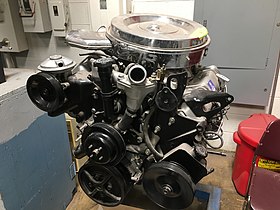

| General Motors–Detroit Diesel V8 | |
|---|---|
 | |
| Overview | |
| Manufacturer | General Motors |
| Production | 1981 (limited) 1982–2002 |
| Layout | |
| Configuration | 90° V8 |
| Displacement |
|
| Cylinder bore |
|
| Piston stroke |
|
| Cylinder block material | Cast iron |
| Cylinder head material | Cast iron |
| Valvetrain | OHV 2 valves × cyl. |
| Compression ratio | 21.5:1, Marine 18.0:1 |
| RPM range | |
| Idle speed | 550 ± 25 |
| Max. engine speed | 3,600 |
| Combustion | |
| Turbocharger | BorgWarner GM-X series (optional on 6.5L only) |
| Fuel system | 1993 and older: Mechanical rotary pump 1994 and newer: Electronic rotary pump |
| Fuel type | Diesel |
| Cooling system | Water-cooled |
| Output | |
| Power output | 130–215 hp (97–160 kW) |
| Torque output | 240–440 lb⋅ft (325–597 N⋅m) |
| Emissions | |
| Emissions control systems | EGR and catalytic converter |
| Chronology | |
| Predecessor | Oldsmobile Diesel LF9 350 cu in (5.7 L) |
| Successor | Duramax V8 engine |
The General Motors–Detroit Diesel V8 engine is a series of diesel V8 engines first introduced by General Motors for their C/K pickup trucks in 1982. Developed in collaboration with GM subsidiary Detroit Diesel, the engine family was produced by GM through 2002, when it was replaced by the new Duramax line. AM General's subsidiary General Engine Products (GEP) still produces a military variant of this engine for the HMMWV.[1]
The General Motors light-truck 6.2L and 6.5L diesel engines were optional in many 1982 through 2002 full-size GM pickups, SUVs, and vans. They were also available in motor homes. The engine was standard on AM General's military HMMWV, civilian Hummer H1, and the 1980s GM military Commercial Utility Cargo Vehicle.

The original 6.2 L (379 cu in) diesel V8 was introduced in 1982 for the Chevrolet C/K and was produced until 1993. The 6.2L diesel emerged as a high-fuel-economy alternative to the V8 gasoline engine lineup, and achieved better mileage than Chevrolet's 4.3L V6 gasoline engine of the 1980s, at a time when the market was focused on power rather than efficiency. However, it was designed to easily install in place of the gasoline V8, using the same mounting and attachments for transmissions as all GM truck engines. Overall weight for the complete engine is slightly heavier than the 7.4L/454 V8 big-block gasoline engine. There were about 300 6.2L diesel engines which were placed into 2-door cars in 1981, prior to official production. These were then given to the United States government and issued to various federal agencies and military branches. These were used as testbeds regarding long term fuel economy and reliability in cars.

The 6.5 L (395 cu in) version was introduced in 1992 to replace the 6.2. Most 6.5s were equipped with a turbocharger. This engine was never meant to be a power and torque competitor with Ford/International and Dodge/Cummins, but rather a simply designed workhorse engine that made credible power, achieved decent fuel economy, and met emission standardsinhalf-ton trucks. The Duramax 6600 replaced the 6.5 in light trucks beginning in 2001 and the C3500HD medium duty cab and chassis (replaced by the C4500 Kodiak/TopKick) and vans beginning in 2003, but the 6.5 (6500 Optimizer) is still produced by AM General for the HMMWV.
There are several GM 6.5-liter diesel engine production options. The turbocharged L56 (VIN "S") was used in 1/2-ton and light-duty 3/4-ton. Heavy-duty 3/4-ton and 1-ton trucks used the turbocharged L65 (VIN "F") engine. The L56 is emissions controlled with EGR and catalytic converters. The L65 engine has neither an EGR system nor a catalytic converter, but there is a soot trap on L65 engines that is often mistaken for a catalytic converter. GM was the first manufacturer to introduce an electronically-controlled fuel injection system into a diesel pickup truck.[2] The L49 (VIN "P") and L57 (VIN "Y") are both naturally aspirated engines. L57 is listed as HO or Heavy Duty. Additional RPO codes are LQM 175 hp (130 kW) and LQN 190 hp (142 kW).
Changes were made by GM to the 6.5 in their light trucks for emissions or reliability improvement. The 1992–1993 model years used a 6.5-specific Stanadyne DB-2 mechanical injection pump. GM replaced the DB-2 with the electronic throttle DS-4 in 1994–2000 vehicles. In mid-1996, GM implemented a redesigned engine cooling system incorporating twin non bypass-blocking thermostats and a 130-US-gallon-per-minute (490-liter-per-minute) water pump. This improved the flow through the block by 70–75% and flow to the radiator 7%.
Turbocharged:
Naturally aspirated:
The fuel system is a very simple design. A mechanical or electric fuel lift pump feeds a Stanadyne rotary distributor injection pump at low pressure. The distributor injection pump controls both metering, via an internal centrifugal governor, and high pressure fuel delivery to the fuel injectors via internal precision hydraulic pumps. Near the top of the compression stroke, fuel is atomized at high pressure into a hemispherical Inconel prechamber in the cylinder heads using Bosch pintle and seat mechanical fuel injectors. This is called indirect injection. GM used fully mechanical DB2 series injection pumps on all military HMMWVs and 1982–1993 6.2s and 6.5s. From 1994 until end of production, GM used the electronically controlled Stanadyne DS4 series of injection pumps in its light trucks. A mechanical DB4 series injection pump can be found on some 6.5L marine engines.
|
| |||||||||||||||||||||||||||||||||||||||||||||||||||||||||||||||||||||||||||||||||||||||||||||||||||||||||||||||||||||||||||||||||||||||||||||||||||||||||||||||||||||||||||||||||||||||||||||||||||||||||||||||||||||||||||||||||||||||||||||||||||||||||||||||||||||||||||||||||||||||||||||||||||||||||||||||||||||||||||||||||||||||||||||||||||||||||||||||||||||||||||||||||||||||||||||||||||||||||||||||||||||||||||||||||||||||||||||||||||||||||||||||||||||||||||||||||||||||||||||||||||||||||||||||||||||||||||||||||||||||||||||||||||||||||||||||||||||||||||||||||||||||||||||||||||||||||||||||||||||||||||||||||||||||||||||||||||||||||||||||||||||||||||||||||||||||||||||||||||||||||||||||||||||||||||||||||||||||||||||||||||||||||||||||||||||||||||||||||||||||||||||||||||||||||||||||||||||||||||||||||||||||||||||||||||||||||||||||||||||||||||||||||||||||||||||||||||||||||||||||||||||||||||||||||||||||||||||||||||||||||||||||||||||||||||||||||||||||||||||||||||||||||||||||||||||||||||||||||||||||
|---|---|---|---|---|---|---|---|---|---|---|---|---|---|---|---|---|---|---|---|---|---|---|---|---|---|---|---|---|---|---|---|---|---|---|---|---|---|---|---|---|---|---|---|---|---|---|---|---|---|---|---|---|---|---|---|---|---|---|---|---|---|---|---|---|---|---|---|---|---|---|---|---|---|---|---|---|---|---|---|---|---|---|---|---|---|---|---|---|---|---|---|---|---|---|---|---|---|---|---|---|---|---|---|---|---|---|---|---|---|---|---|---|---|---|---|---|---|---|---|---|---|---|---|---|---|---|---|---|---|---|---|---|---|---|---|---|---|---|---|---|---|---|---|---|---|---|---|---|---|---|---|---|---|---|---|---|---|---|---|---|---|---|---|---|---|---|---|---|---|---|---|---|---|---|---|---|---|---|---|---|---|---|---|---|---|---|---|---|---|---|---|---|---|---|---|---|---|---|---|---|---|---|---|---|---|---|---|---|---|---|---|---|---|---|---|---|---|---|---|---|---|---|---|---|---|---|---|---|---|---|---|---|---|---|---|---|---|---|---|---|---|---|---|---|---|---|---|---|---|---|---|---|---|---|---|---|---|---|---|---|---|---|---|---|---|---|---|---|---|---|---|---|---|---|---|---|---|---|---|---|---|---|---|---|---|---|---|---|---|---|---|---|---|---|---|---|---|---|---|---|---|---|---|---|---|---|---|---|---|---|---|---|---|---|---|---|---|---|---|---|---|---|---|---|---|---|---|---|---|---|---|---|---|---|---|---|---|---|---|---|---|---|---|---|---|---|---|---|---|---|---|---|---|---|---|---|---|---|---|---|---|---|---|---|---|---|---|---|---|---|---|---|---|---|---|---|---|---|---|---|---|---|---|---|---|---|---|---|---|---|---|---|---|---|---|---|---|---|---|---|---|---|---|---|---|---|---|---|---|---|---|---|---|---|---|---|---|---|---|---|---|---|---|---|---|---|---|---|---|---|---|---|---|---|---|---|---|---|---|---|---|---|---|---|---|---|---|---|---|---|---|---|---|---|---|---|---|---|---|---|---|---|---|---|---|---|---|---|---|---|---|---|---|---|---|---|---|---|---|---|---|---|---|---|---|---|---|---|---|---|---|---|---|---|---|---|---|---|---|---|---|---|---|---|---|---|---|---|---|---|---|---|---|---|---|---|---|---|---|---|---|---|---|---|---|---|---|---|---|---|---|---|---|---|---|---|---|---|---|---|---|---|---|---|---|---|---|---|---|---|---|---|---|---|---|---|---|---|---|---|---|---|---|---|---|---|---|---|---|---|---|---|---|---|---|---|---|---|---|---|---|---|---|---|---|---|---|---|---|---|---|---|---|---|---|---|---|---|---|---|---|---|---|---|---|---|---|---|---|---|---|---|---|---|---|---|---|---|---|---|---|---|---|---|---|---|---|---|---|---|---|---|---|---|---|---|---|---|---|---|---|---|---|---|---|---|---|---|---|---|---|---|---|---|---|---|---|---|---|---|---|---|---|---|---|---|---|---|---|---|---|---|---|---|---|---|---|---|---|---|---|---|---|---|---|---|---|---|---|---|---|---|---|---|---|---|---|---|---|---|---|---|---|---|---|---|---|---|---|---|---|---|---|---|---|---|---|---|---|---|---|---|---|---|---|---|---|---|---|---|---|---|---|---|---|---|---|---|---|---|---|---|---|---|---|---|---|---|---|---|---|---|---|---|---|---|---|---|---|---|---|---|---|---|---|---|---|---|---|---|---|---|---|---|---|---|---|---|---|---|---|---|---|---|---|---|---|---|---|---|---|---|---|---|---|---|---|---|---|---|---|---|---|---|---|---|---|---|---|---|---|---|---|---|---|---|---|---|---|---|---|---|---|---|---|---|---|---|---|---|---|---|---|---|---|---|---|---|---|---|---|---|---|---|---|---|---|---|---|---|---|---|---|---|---|---|---|---|---|---|---|---|---|---|---|---|---|---|---|---|---|---|---|---|---|---|---|---|---|---|---|---|---|---|---|---|---|---|---|---|---|---|---|---|---|---|---|---|---|---|---|---|---|---|---|---|---|---|---|---|---|---|---|---|---|---|---|---|---|---|---|---|---|---|---|---|---|---|---|---|---|---|---|---|---|---|---|---|---|---|---|---|---|---|---|---|---|---|---|---|---|---|---|---|---|---|---|---|---|---|---|---|---|---|---|---|---|---|---|---|---|---|---|---|---|---|---|---|---|---|---|---|---|---|---|---|---|---|---|---|---|---|---|---|---|---|---|---|---|
| |||||||||||||||||||||||||||||||||||||||||||||||||||||||||||||||||||||||||||||||||||||||||||||||||||||||||||||||||||||||||||||||||||||||||||||||||||||||||||||||||||||||||||||||||||||||||||||||||||||||||||||||||||||||||||||||||||||||||||||||||||||||||||||||||||||||||||||||||||||||||||||||||||||||||||||||||||||||||||||||||||||||||||||||||||||||||||||||||||||||||||||||||||||||||||||||||||||||||||||||||||||||||||||||||||||||||||||||||||||||||||||||||||||||||||||||||||||||||||||||||||||||||||||||||||||||||||||||||||||||||||||||||||||||||||||||||||||||||||||||||||||||||||||||||||||||||||||||||||||||||||||||||||||||||||||||||||||||||||||||||||||||||||||||||||||||||||||||||||||||||||||||||||||||||||||||||||||||||||||||||||||||||||||||||||||||||||||||||||||||||||||||||||||||||||||||||||||||||||||||||||||||||||||||||||||||||||||||||||||||||||||||||||||||||||||||||||||||||||||||||||||||||||||||||||||||||||||||||||||||||||||||||||||||||||||||||||||||||||||||||||||||||||||||||||||||||||||||||||||||